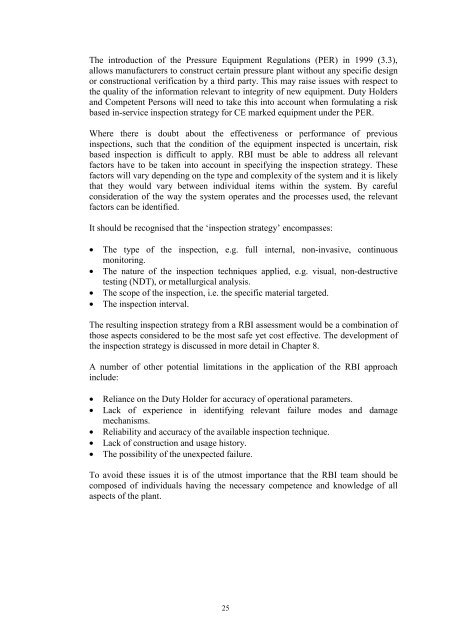Best Practice for Risk Based Inspection
risk based inspection
risk based inspection
Create successful ePaper yourself
Turn your PDF publications into a flip-book with our unique Google optimized e-Paper software.
The introduction of the Pressure Equipment Regulations (PER) in 1999 (3.3),<br />
allows manufacturers to construct certain pressure plant without any specific design<br />
or constructional verification by a third party. This may raise issues with respect to<br />
the quality of the in<strong>for</strong>mation relevant to integrity of new equipment. Duty Holders<br />
and Competent Persons will need to take this into account when <strong>for</strong>mulating a risk<br />
based in-service inspection strategy <strong>for</strong> CE marked equipment under the PER.<br />
Where there is doubt about the effectiveness or per<strong>for</strong>mance of previous<br />
inspections, such that the condition of the equipment inspected is uncertain, risk<br />
based inspection is difficult to apply. RBI must be able to address all relevant<br />
factors have to be taken into account in specifying the inspection strategy. These<br />
factors will vary depending on the type and complexity of the system and it is likely<br />
that they would vary between individual items within the system. By careful<br />
consideration of the way the system operates and the processes used, the relevant<br />
factors can be identified.<br />
It should be recognised that the ‘inspection strategy’ encompasses:<br />
• The type of the inspection, e.g. full internal, non-invasive, continuous<br />
monitoring.<br />
• The nature of the inspection techniques applied, e.g. visual, non-destructive<br />
testing (NDT), or metallurgical analysis.<br />
• The scope of the inspection, i.e. the specific material targeted.<br />
• The inspection interval.<br />
The resulting inspection strategy from a RBI assessment would be a combination of<br />
those aspects considered to be the most safe yet cost effective. The development of<br />
the inspection strategy is discussed in more detail in Chapter 8.<br />
A number of other potential limitations in the application of the RBI approach<br />
include:<br />
• Reliance on the Duty Holder <strong>for</strong> accuracy of operational parameters.<br />
• Lack of experience in identifying relevant failure modes and damage<br />
mechanisms.<br />
• Reliability and accuracy of the available inspection technique.<br />
• Lack of construction and usage history.<br />
• The possibility of the unexpected failure.<br />
To avoid these issues it is of the utmost importance that the RBI team should be<br />
composed of individuals having the necessary competence and knowledge of all<br />
aspects of the plant.<br />
25



